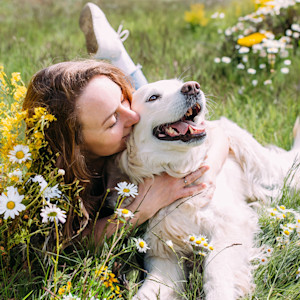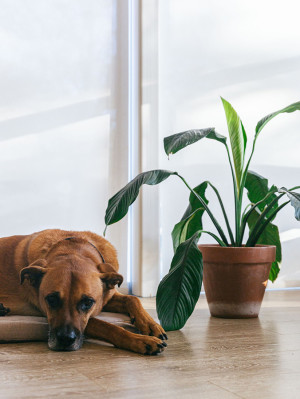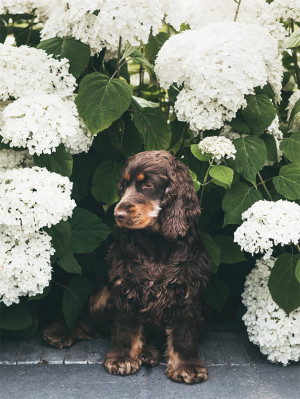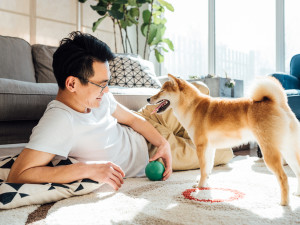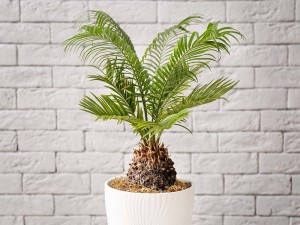Are Hibiscus Plants Toxic to Your Dog?
They’re bright and pretty—just like your pup. But are they safe?

Share Article
The hibiscus is a warm-weather perennial plant that is popular for its vibrant flowers and potential health benefits. Yes, the hibiscus is generally considered to be a non-toxic plant but can cause gastrointestinal upset in dogs if ingested.
Hibiscus plants can be found in many homes and gardens. Its tart, sour flavor makes hibiscus a popular ingredient for teas, jams, desserts, and cocktails with your favorite liquor. Hibiscus teas made from the calyx (the part of the plant that supports that flower) are known for their potential health benefits, including helping to reduce blood sugar, blood pressure, and bad cholesterol levels.
There are many species of hibiscus plant, but popular varieties include:
Roselle (Hibiscus sabdariffa)
Chinese hibiscus (Hibiscus rosa-sinensis)
Rose of Sharon hibiscus (Hibiscus syriacus)
The Roselle variety is what is most commonly used to make hibiscus tea. Rose of Sharon hibiscus is a popular garden flower. Chinese hibiscus is versatile, in that it is used both for garden ornamentation and to make tea, but proof of its potential health benefits is lacking.

It’s important to note that “rose of Sharon” is sometimes used as a common name for Hypericum calycinum, also known as St. John’s wort or Klamath weed. Hypericum calycinum plants contain hypericin, a toxin that can cause contact dermatitis and photosensitivity in dogs and humans.
Why is hybiscus dangerous to dogs?
Hibiscus is generally considered to be a non-toxic plant and there are no components that are known to be dangerous to dogs. However, some dogs will experience mild to moderate gastrointestinal upset after eating hibiscus.
Some dogs can nibble on hibiscus without any issues, but because there is no way to know how your dog will respond after eating hibiscus, it’s best to prevent ingestion all together. Plus, there are no documented health benefits for dogs, so why risk unnecessary bouts of diarrhea?
What should I do if my dog has eaten hibiscus?
There’s no need to panic if your dog eats hibiscus, but you shouldn’t forget about it either. Because the likelihood of your dog experiencing ill effects from ingesting hibiscus is unknown, careful monitoring is recommended. Take note of which parts of the plant and the amount your dog ingested. Also, be sure to have information available about any fertilizer or pesticides that may have been applied t o the plant recently.
If your dog develops any symptoms, contact a veterinarian or an animal poison control center for guidance. A veterinary professional can use your dog’s history, exposure, and symptoms to help determine if medical care is needed.
Diagnosing plant poisoning in dogs
Witnessing your dog in the act of gnawing on a plant is the best way to determine that they ate a plant that they shouldn't. Dogs tend to be careless about leaving evidence behind, so finding obviously disturbed plants is another sign. If your dog develops vomiting or diarrhea after eating hibiscus, consult with your vet.
Symptoms of hibiscus plant poisoning in dogs
Not all dogs will develop symptoms after ingesting hibiscus. Dogs that get sick after eating hibiscus typically experience mild gastrointestinal upset. The more hibiscus a dog ingests, the more likely they are to develop symptoms. Ingesting Hibiscus syriacus, the rose of Sharon variety of hibiscus, is also thought to be more likely to cause symptoms in dogs. Symptoms of hibiscus plant poisoning in dogs include:
Drooling
Nausea
Vomiting
Diarrhea
Treatment for hibiscus poisoning in dogs
Treatment for hibiscus poisoning in dogs is symptomatic in nature and can usually be performed on an outpatient basis. Depending on your dog’s symptoms, your vet may give medications for nausea, vomiting, and/or diarrhea. Fluid therapy may be recommended if your dog is dehydrated. Early intervention can make your dog feel better quickly. If symptoms persist without treatment, dogs can become dehydrated, leading to lethargy and electrolyte imbalances.
How do you prevent plant poisoning in dogs?
Dog parents can prevent plant poisoning by being vigilant about the types of plants their dog has access to. Choose only pet-safe houseplants and ensure you know the species of plants and flowers included in any gifts or bouquets. Plant a pet-safe garden. If there are plants that may pose a problem for your dog, fence the garden off so that it’s off limits.
The bottom line: Is hibiscus poisonous to my dog?
Hibiscus is generally not considered to be toxic to dogs. However, some dogs will develop mild to moderate gastrointestinal upset after eating hibiscus. The more hibiscus a dog eats, the more likely they are to have symptoms. Anecdotally, the rose of Sharon variety of hibiscus, Hibiscus syriacus, is more likely to cause symptoms in dogs.
Other flowers that are safe for dogs
Echinaea (Echinacea purpurea): Also known as the purple coneflower, echinacea is another plant hailed for its possible human health benefits.
Sunflowers (Helianthus angustifolius): These happy, golden-yellow flowers can brighten up any bouquet or anyone’s day. They’re also safe for your happy dog to be around.
Asters (Callistephus chinensis): The bright flowers bloom from summer to fall and are safe for your pup.
Other flowers that are dangerous for dogs
Mums (Chrysanthemum spp.): Chrysanthemums contain multiple toxic components, and no part of the plant is safe for dogs to ingest. Symptoms of chrysanthemum poisoning in dogs include drooling, vomiting, diarrhea, incoordination, and skin irritation.
Persian cyclamen (Cyclamen persicum): This flower is also called “florist’s cyclamen” and contains saponins, which are toxic to dogs. Ingestion can lead to gastrointestinal signs including drooling, vomiting, and diarrhea. In large amounts, persian cyclamen ingestion can cause cardiac and neurological symptoms, including abnormal heart rhythm and seizures.
Azaleas (Rhododendron spp.): These flowering shrubs are toxic to dogs. Azaleas contain high concentrations of a neurotoxin called grayanotoxin. Dogs that ingest any part of an azalea plant can develop vomiting, diarrhea, weakness, tremors, blindness, seizures, and abnormal heart rhythm. Any dog that ingests azalea plants should receive prompt veterinary care.
FAQs (People also ask):
What happens if my dog eats hibiscus?
In many cases, nothing will happen if your dog eats a small amount of hibiscus. But some dogs will experience mild to moderate GI upset including nausea, vomiting, and/or diarrhea.
Can dogs eat hibiscus flowers?
Eating any part of a hibiscus plant, including the flowers, can cause a dog to develop mild GI signs. Dogs should not be fed hibiscus flowers. There is no documented health benefit to giving a dog hibiscus flowers.
Are hibiscus plants poisonous to dogs if they smell them?
Hibiscus is not poisonous to dogs if they smell them. Your pup can safely sniff away at any hibiscus plants in your home or garden.
Can I use shampoo with hibiscus on my dog?
Shampoos with hibiscus are safe to use on dogs as long as they are shampoos that are formulated specifically for dog skin. Don’t bathe a dog with human shampoo. If your dog has skin issues, discuss the best shampoo options with your vet.
References:
North Carolina Extension Gardener Plant Toolbox opens in new tab
Colorado State University Guide to Poisonous Plantsopens in new tab

Dr. Alycia Washington, DVM, MS
Alycia Washington is a small-animal emergency veterinarian with over 10 years of experience based in North Carolina. She works as a relief veterinarianopens in new tab and provides services to numerous emergency and specialty hospitals. She also works as a veterinary writer with a focus on educating pet parents.
Related articles
Are Peace Lilies Toxic to Dogs?
Keep your pup far away from the toxic plant.
Are Hydrangeas Toxic to My Dog?
You can live your best New England cottage life. Just keep your dog away from this plant.
![Man laying on floor playing with dog]()
How to Puppy Proof Your Home
Is your home a danger zone for a new dog? Follow these pro tips.
![A Sago Palm in a white pot against a grey brick background]()
Two Georgia Dogs Died After Consuming the Toxic Sago Palm
It looks cute, but this plant is incredibly deadly to dogs. Here’s everything you need to know.

